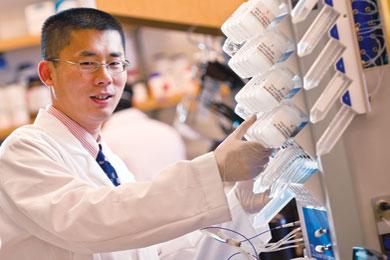CERSI Conference Explores Methods to Measure Protein Aggregation
Researchers from academia, government, and industry examine both established and emerging techniques to detect protein aggregation in biologic drug products.

By Malissa Carroll
January 12, 2017
The University of Maryland School of Pharmacy welcomed researchers from across academia, government, and industry to Pharmacy Hall in December for “Protein Aggregation Measurement in Biotherapeutics: Established and Emerging Techniques,” a day-long conference sponsored by the University of Maryland Center of Excellence in Regulatory Science and Innovation (M-CERSI) and the Bio- and Nano-technology Center at the School of Pharmacy. Led by Bruce Yu, PhD, professor in the Department of Pharmaceutical Sciences (PSC) and director of the Bio- and Nano-technology Center, the conference explored both established and emerging technologies to detect and measure protein aggregation in biologic drug products.
“The organizers of this conference have assembled presentations that represent the diverse perspectives of experts from academic institutions, regulatory agencies, and pharmaceutical companies across the nation,” said Natalie D. Eddington, PhD, FCP, FAAPS, dean and professor of the School of Pharmacy, in her welcoming remarks to attendees. “As separate entities, it can be difficult to move scientific concepts for new drugs and improved drug delivery systems into the hands of those who need them most – our patients. However, if we work together and harness our collective ingenuity, I am confident that we will find that we have the knowledge, skills, and ability to make a significant and real impact on the treatment of a host of chronic diseases.”
Unlike most medications that are developed through chemical syntheses, biologics are made with living cells. These drugs – which include vaccines, medications for cancer and autoimmune diseases, as well as emerging drugs for cell and gene therapies – represent the cutting-edge of biomedical research and often succeed where traditional drug treatments have failed. However, when the proteins that make up some biologic drugs aggregate, or clump together, the safety and efficacy of those drugs can be severely compromised.
The first step in addressing protein aggregation in biologic products is to detect when aggregation has occurred. To kick off the conference, Yu delivered a brief presentation that spotlighted an emerging method currently under investigation in his laboratory to non-invasively detect protein aggregation using water proton nuclear magnetic resonance (NMR). He outlined several experiments that his team had conducted examining the transverse relaxation rate of water protons in NMR and discussed how the results of those experiments might be applied in manufacturing and clinical settings.
“Water NMR offers a number of benefits when compared to other analytical technologies,” said Yu. “It is not only inexpensive, fast, and easy to perform, but also non-invasive. Traditional pharmaceutical analyses often require the tester to open the product, draw out the solution, and inject it into another device. Once the product has been opened, it cannot be dispensed to patients for use. Water NMR allows the tester to insert the entire vial with its cap and label still intact for analysis. There is no tampering with the drug, and it can still be used by patients if the analysis shows no indication of protein aggregation.”
As Yu explained the benefits associated with water NMR, he noted that the method was likely not appropriate for all pharmaceutical analyses. “Although there are a number of applications that can benefit from non-invasive analyses such as water NMR, there are certain applications for which more invasive analyses must be performed. It is crucial that we continue to research other analytical technologies to meet the diverse needs of all researchers, manufacturers, and clinicians, and to ensure that the products we provide to our patients are safe and effective,” he added.
Following Yu’s presentation, the conference was divided into four sessions that explored the regulatory challenges associated with analytical technologies, the applications and limitations associated with common technologies, optical techniques such as counting and characterization, and techniques available through NMR and mass spectrometry.
“NMR is an excellent tool that can give researchers a picture of the ‘state’ of a protein,” said David Keire, PhD, acting laboratory chief for the Office of Pharmaceutical Quality in the Center for Drug Evaluation and Research at the Food and Drug Administration (FDA), who delivered a presentation titled “Applications of NMR for Assessing the Higher Order Structure of Protein Therapeutics.” “Although NMR has been used by researchers to analyze proteins for many years, it has not been widely applied to the understanding of protein aggregation. Our research aims to change this practice.”
The conference concluded with a panel discussion during which all presenters were invited to address questions posed by audience members.
“As researchers and manufacturers, we are all familiar with the challenges that protein aggregation presents for the development of new biologic therapies,” said Ewa Marszal, PhD, chemist in the Center for Biologics Evaluations and Research at the FDA. “Understanding both the established and emerging techniques that are available to detect and measure protein aggregation is crucial to ensuring the quality and safety of these products. It is truly an area that requires much more research and attention, and I thank you all for attending this conference and affirming your dedication to this important field.”


